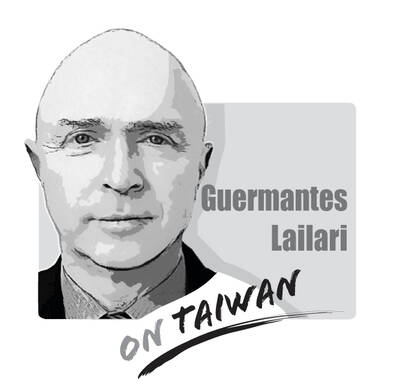The Chinese Nationalist Party (KMT) has its chairperson election tomorrow. Although the party has long positioned itself as “China friendly,” the election is overshadowed by “an overwhelming wave of Chinese intervention.”
The six candidates vying for the chair are former Taipei mayor Hau Lung-bin (郝龍斌), former lawmaker Cheng Li-wen (鄭麗文), Legislator Luo Chih-chiang (羅智強), Sun Yat-sen School president Chang Ya-chung (張亞中), former National Assembly representative Tsai Chih-hong (蔡志弘) and former Changhua County comissioner Zhuo Bo-yuan (卓伯源).
While Cheng and Hau are front-runners in different surveys, Hau has complained of an online defamation campaign against him coming from accounts with foreign IP addresses, including a fabricated video showing Hau kissing a Taipei city councilor in public.
Former Broadcasting Corp of China chairman Jaw Shaw-kong (趙少康) alleged that a significant number of the Web accounts attacking Hau are based in China, and using artificial intelligence (AI) this adroitly to fabricate fake images and the sheer quantity of “fake news” has displayed capabilities beyond an individual Internet user.
According to Jaw and a preliminary investigation by the National Security Bureau, in the past month, there were more than 1,200 video clips about the KMT election being released on Chinese TikTok (Douyin) and YouTube, most of which criticize Hau, but praise Cheng, who has frequently echoed China’s “one China principle,” vowed to “make all Taiwanese proud to be ‘Chinese,’” and is widely seen as more China-leaning.
China has a long history of interference in other countries’ political affairs and elections in support of its geopolitical objectives, targeting Taiwan and other democratic countries to support candidates most in line with the ambitious authoritarian’s interests. The US, Canada, South Korea, the Philippines and several European countries all have given evidence accusing China of interfering in elections.
During Taiwan’s presidential election last year, the National Security Bureau recorded at least 115 cases of Chinese interference operations, including sponsoring specific groups’ electioneering and trips to China for vote-buying purposes, as well as recruiting online influencers to build support for pro-China candidates, while stigmatizing the government and ruling party to accelerate social fracturing.
Ironically, though the KMT has long been identified as a China-leaning party, it cannot avoid China’s devious interference and manipulation in its elections. These incidents have been a warning that Beijing’s political interventions and interference not only target the ruling government and party, but now extend to the opposition.
KMT politicians have repeatedly hindered legislation to counter Beijing’s hostile cognitive warfare activities, “gray zone” tactics and political infiltrations. The party even proposed legislation to amend or abolish the Anti-infiltration Act (反滲透法) after KMT dignitaries, such as former president Ma Ying-jeou (馬英九) and KMT caucus whip Fu Kun-chi (?), took trips to China.
Now the party has to eat the bitter fruit. Jaw and other KMT heavyweights have called on Beijing to stop meddling in KMT elections, and declared a national security incident that should be contained.
No matter who wins the KMT election, China’s political infiltration and manipulations targeting Taiwanese political parties are going to continue.
To counter hostile foreign interventions and attacks is a substantial challenge and would take lots of effort, such as cybersecurity and AI technology upgrades, as well as legislative amendments and enforcement, including the National Security Act (國家安全法), Anti-infiltration Act (反滲透法) and Cyber Security Management Act (資通安全管理法). Most importantly, all political parties should work together to defend national security and against external threats.

Chinese state-owned companies COSCO Shipping Corporation and China Merchants have a 30 percent stake in Kaohsiung Port’s Kao Ming Container Terminal (Terminal No. 6) and COSCO leases Berths 65 and 66. It is extremely dangerous to allow Chinese companies or state-owned companies to operate critical infrastructure. Deterrence theorists are familiar with the concepts of deterrence “by punishment” and “by denial.” Deterrence by punishment threatens an aggressor with prohibitive costs (like retaliation or sanctions) that outweigh the benefits of their action, while deterrence by denial aims to make an attack so difficult that it becomes pointless. Elbridge Colby, currently serving as the Under
The Ministry of the Interior on Thursday last week said it ordered Internet service providers to block access to Chinese social media platform Xiaohongshu (小紅書, also known as RedNote in English) for a year, citing security risks and more than 1,700 alleged fraud cases on the platform since last year. The order took effect immediately, abruptly affecting more than 3 million users in Taiwan, and sparked discussions among politicians, online influencers and the public. The platform is often described as China’s version of Instagram or Pinterest, combining visual social media with e-commerce, and its users are predominantly young urban women,
Most Hong Kongers ignored the elections for its Legislative Council (LegCo) in 2021 and did so once again on Sunday. Unlike in 2021, moderate democrats who pledged their allegiance to Beijing were absent from the ballots this year. The electoral system overhaul is apparent revenge by Beijing for the democracy movement. On Sunday, the Hong Kong “patriots-only” election of the LegCo had a record-low turnout in the five geographical constituencies, with only 1.3 million people casting their ballots on the only seats that most Hong Kongers are eligible to vote for. Blank and invalid votes were up 50 percent from the previous
Japanese Prime Minister Sanae Takaichi lit a fuse the moment she declared that trouble for Taiwan means trouble for Japan. Beijing roared, Tokyo braced and like a plot twist nobody expected that early in the story, US President Donald Trump suddenly picked up the phone to talk to her. For a man who normally prefers to keep Asia guessing, the move itself was striking. What followed was even more intriguing. No one outside the room knows the exact phrasing, the tone or the diplomatic eyebrow raises exchanged, but the broad takeaway circulating among people familiar with the call was this: Trump did